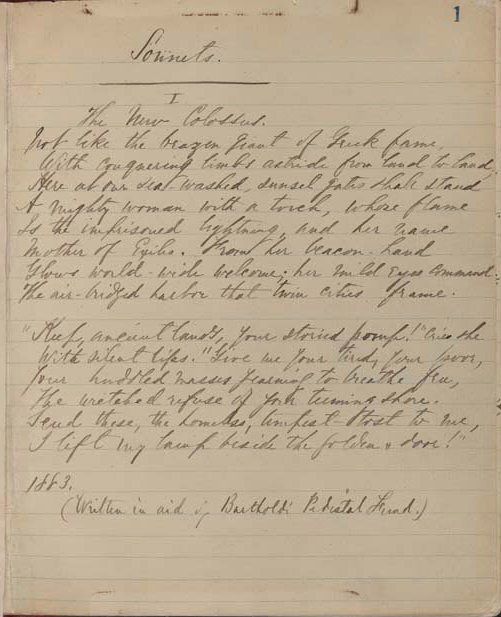How do archives collect girl authors? In this interview series, we welcome curators and archivists to share how their institutions collect and utilize materials by girls who were or became published authors in their youth. Today, we look at the papers of Emma Lazarus (1849-1887), best known as the author of “The New Colossus,” a poem now inscribed on the Statue of Liberty at Ellis Island, New York. Special thanks to Melanie Myers, Director of Collections and Engagement, at the American Jewish Historical Society.
What kinds of records do you keep relating to the author?
AJHS holds archival and library collections related to Emma Lazarus as well as her family; the collection contains a small quantity of autographed letters, a scrapbook about her career and tributes after her untimely death, and a collection of condolence letters sent to The American Hebrew after the announcement of her death. The condolence letters are from members of the general public- people who read her books and poems, and were touched by her writings. The archival collection also contains a manuscript notebook that Lazarus purchased towards the end of her life, as her health was starting to fail- in this notebook, she set down her poems, in her own hand, and in the order in which she felt best represented her work. The first poem in the book is “The New Colossus”, her best known poem- but the poem only was added to the Statue of Liberty long after her death, when it gained a wider audience. AJHS also has an extensive collection of her printed books in first editions; titles such as Admetus and Other Poems, and other volumes of her collected works are included.
Do you have physical objects in the archives from the author?
We do not have items such as that; as an archive, we are best suited to preserving paper based items.
How are the records utilized? Do researchers use items for books/articles or for historical research for movies or tv shows?
The bulk of our researchers use the collections for books and articles about Emma Lazarus and others in her circle of friends and family; a great deal of scholarly work on Emma Lazarus has been produced using materials found at the AJHS. Additionally, we hold the archival collection of Morris Schappes, a professor who did some of the first scholarly work on her poems; his collection contains his draft versions and notes of his published materials about Lazarus, which is also of assistance to new scholars. Additionally, all of the materials in the Emma Lazarus collection, including the manuscript notebook, are fully digitized and available free of charge to any researcher; these materials can be found by searching for “Emma Lazarus” at search.cjh.org. AJHS has also used these materials ourselves to create a curriculum and immersive exhibition about Emma; these materials can be found via https://ajhs.org/emma-lazarus-project.
What is your favourite object/document/record in the collections related to this author?
The manuscript notebook is a beautiful and touching object- to hold it is truly a magical experience. But I also find the condolence letters very moving, as they show the impact her poems and writings had on a wide group of people; individuals who did not know her personally at all, who only knew her through her writings and yet felt a personal loss from her untimely passing.

